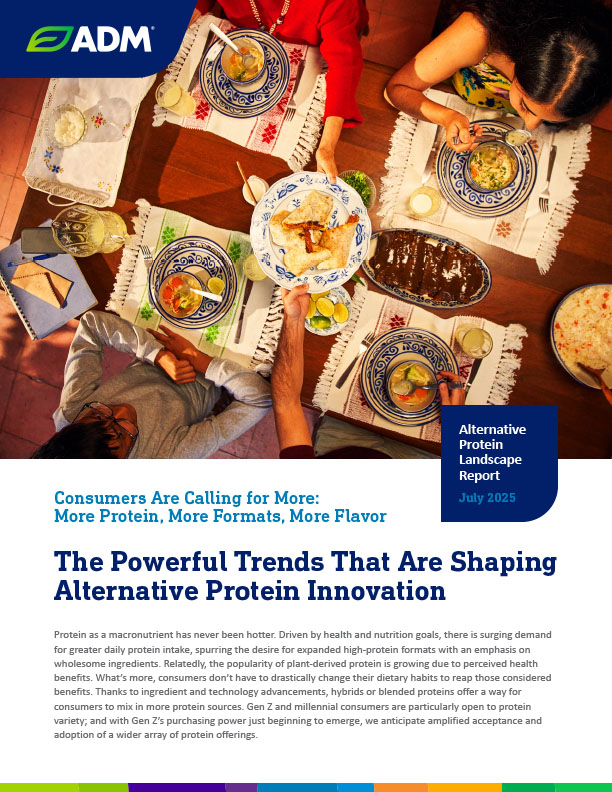

ADM sees soaring demand for alternative proteins as consumers seek variety and health benefits
Global interest in alternative proteins has reached new heights, according to ADM’s latest Alternative Protein Landscape Report, with consumers across generations demanding higher protein content, new formats, and better taste experiences – and increasingly open to exploring everything from soy and chickpeas to fermentation-derived proteins.
ADM’s report, released in July 2025, reveals how shifting dietary patterns are reshaping the protein market, as health-conscious consumers look for ways to boost their daily intake without drastically changing their eating habits. “Protein as a macronutrient has never been hotter,” the report states, noting that consumers are driving demand for “expanded high-protein formats with an emphasis on wholesome ingredients”.
A key force behind this trend is the growing number of flexitarians – people who actively try to eat more plant-based products while still consuming some animal-based foods. Globally, 46% of consumers now identify as flexitarians, with the highest proportions in Germany, South Korea, and a tie between the USA and Brazil. Health remains the biggest motivator for adopting a flexitarian lifestyle, with 86% of plant-forward consumers believing it’s healthier to get protein from a variety of sources.
Meanwhile, vegetarians account for about 4% of global consumers, while only 1% identify as vegan. But the largest group remains 'carefree' consumers – those who don’t intentionally seek out or avoid plant- or animal-based products. Representing 49% of global consumers, this segment offers significant potential for innovation. While many carefree consumers put taste above nutrition, ADM’s data shows that 67% believe eating more plant proteins would improve their health, and 73% agree it’s healthier to consume protein from diverse sources.
Legacy plant proteins such as soy continue to resonate, particularly among younger consumers. Soy ranks among the top five most recognized plant protein sources worldwide and is strongly associated with health, taste, and support for active lifestyles. ADM reports that 83% of plant-forward consumers agree soy is a good source of plant protein for building or maintaining muscle, and 81% believe it’s a great option for reducing fat intake.
Beyond soy, chickpeas and lentils are gaining ground. Chickpeas rank in the top three for global plant-forward consumer awareness, with opportunities for incorporation into ready meals, snacks, and foodservice offerings. Lentils, while facing an “awareness-to-consumption gap”, are viewed as highly nutritious and natural, aligning with flexitarians’ desire for health and taste without sacrificing convenience.

Fermentation-derived proteins have emerged as a 'what’s next' technology. The report reveals that 72% of millennials and 68% of Gen Z consumers are interested in trying foods and beverages featuring proteins produced through fermentation. This approach appeals to consumers seeking novel ingredients, with plant-based innovation, hybrid blends, and fermentation all ranking high among plant-forward consumers’ interests across meat, dairy, and specialized nutrition products.
The pursuit of protein spans every age group. According to ADM, 58% of baby boomers, 64% of Generation X, and 70% of both millennials and Gen Z are looking to increase protein in their diets, with some aiming for 30g or more per meal. Notably, nearly 80% of consumers believe eating more plant-based proteins will help them age better, while 78% think it supports muscle maintenance and strength.
Taste remains a crucial factor, especially for carefree consumers who prioritize flavor over nutrition in plant-based products. For global plant-forward consumers, taste and nutrition are equally important for 63% of respondents, with only 21% prioritizing nutrition alone and 16% focusing solely on taste. ADM highlights that product developers have been refining formulations to deliver better sensory experiences, contributing to the growing enthusiasm for alternative proteins.
There’s also a growing connection between the use of anti-obesity medications and interest in plant-based diets. The report notes that 77% of global plant-forward consumers believe plant-based proteins make it easier to lose weight. In the USA, 64% of consumers using anti-obesity medications such as GLP-1 receptor agonists are paying closer attention to protein content, and 44% are intentionally increasing their intake of plant-based proteins. Fiber is also gaining importance, with 49% of GLP-1 users seeking to boost their fiber intake.
Blended products that combine plant and animal proteins are gaining traction as well. Consumers cite benefits such as improved health, environmental impact, dietary variety, and balanced nutrition as reasons for exploring blends. ADM reports high interest in hybrids across generations, with formulations designed to deliver taste and nutritional benefits without forcing major dietary changes.
Even price-conscious shoppers are leaning toward alternatives. Globally, 78% of plant-forward consumers believe private-label plant-based foods and beverages are just as good as branded options, suggesting value-driven innovation has room to grow.
ADM’s report suggests that while legacy proteins like soy will maintain their role, there’s increasing space for novel proteins, blends, and fermentation technologies to satisfy consumer appetites for health, sustainability, and culinary adventure. As the report concludes, “product developers have multiple avenues to meet consumers where they are now while being at the forefront of what’s next in alternative protein innovation.”
If you have any questions or would like to get in touch with us, please email info@futureofproteinproduction.com


-p-800.jpg)



